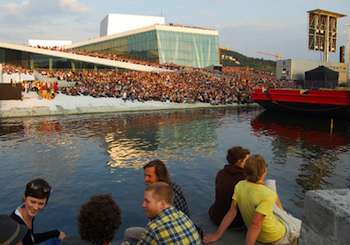- MENU
- HOME
- SEARCH
- WORLD
- MAIN
- AFRICA
- ASIA
- BALKANS
- EUROPE
- LATIN AMERICA
- MIDDLE EAST
- United Kingdom
- United States
- Argentina
- Australia
- Austria
- Benelux
- Brazil
- Canada
- China
- France
- Germany
- Greece
- Hungary
- India
- Indonesia
- Ireland
- Israel
- Italy
- Japan
- Korea
- Mexico
- New Zealand
- Pakistan
- Philippines
- Poland
- Russia
- South Africa
- Spain
- Taiwan
- Turkey
- USA
- BUSINESS
- WEALTH
- STOCKS
- TECH
- HEALTH
- LIFESTYLE
- ENTERTAINMENT
- SPORTS
- RSS
- iHaveNet.com: Travel
By Rick Steves

Oslo's Opera House
The jutting white marble planes of the Opera House roof double as a public plaza -- and concert grandstand
In Oslo, Norway's capital, a big statue of a tiger sits in front of the train station. A local once explained that Oslo is nicknamed the Tiger City because in the 19th century, when country boys would visit the wild and crazy "New York City of Norway," it would "make a mark on their soul."
I find Oslo more of a kitten than a tiger.
Its mix of grand Neoclassical facades, boxy '60s-style modernism, pastoral parks, and homogenous culture have always felt a bit tame for my taste. But by digging deeper, you can find more texture here, from gritty neighborhoods to troubled artists.
The city's grand boulevard, Karl Johans Gate, cuts from the train station through the center of town to the Royal Palace. Lively with restaurants, parks, and people, the street is lined with landmarks, including
The boulevard is also the address of the
Munch is Norway's most famous and influential painter. To see his most important work, head to the nearby
A few blocks down from the
Facing the harbor, Oslo's striking city hall is famous for hosting the Nobel Peace Prize ceremony. Completed in 1950 to celebrate the city's 900th birthday, the building was an avant-garde thrill in its day. Entering here, I'm reminded that in this most highly taxed corner of Europe, city halls, rather than churches, are the dominant buildings. While the state religion is Lutheran, people rarely go to church. Instead, they seem to almost worship good government. In fact, the main hall actually feels like a temple.
Along the eastern harbor, the marble Opera House seems to rise like an iceberg from the sea. This is the only opera house in the world that doubles as a public plaza, with a roof designed to be walked on. Opened in 2008, this cultural venue is a huge hit. On my last visit, I joined 8,000 people on the rooftop to watch a hot English group named Antony and the Johnsons (with a lead singer who looks like a cross between Meatloaf and Marilyn Manson) perform on a stage raft anchored just offshore.
In summer, Norwegians practically live outdoors.
Frogner Park not only offers a great peek at Norwegians at play, but it also features a fine sculpture garden showcasing a lifetime of work by Norway's greatest sculptor, Gustav Vigeland.
From 1924 to 1943, Vigeland created a world of bronze and granite statues -- around 600 nude figures in all. The centerpiece is a teeming monolith of life, with 121 figures carved out of a single block of stone rocketing skyward. Like Munch, Vigeland was troubled. While those who know his life story can read it clearly in the granite and bronze, I ignore it all and simply see his art as observations on the bittersweet cycle of life.
As much as I love Norway, goat cheese, and my blond cousins, sometimes I need to inject some color into my days. At night, I head to two trendy multiethnic zones. Grunerlokka is the Greenwich Village of Oslo. A former working-class district, this neighborhood of funky shops, old hippies, and bohemian cafes is a favorite of Oslo's artsy set. Locals come here for its convivial night scene and colorful eateries.
Oslo's rough and tumble immigrant zone is a stretch of a street called Gronland. This is where Turks, Indians, Pakistanis, and the rest of Oslo's immigrant community congregate. Colorful green grocer carts spill onto sidewalks. Various kebabs and spicy borek cost just $2 to go. Dueling tandoori restaurants offer meals for under $10 -- unheard of in Oslo.
I love dining streetside here.
It's cheap -- and seeing a rainbow of people and a few rough edges makes the city feel less like Wonder bread. But that's the beauty of Oslo. Just when you think you have it figured out, it gives you a taste of something different.
© RICK STEVES DISTRIBUTED BY TRIBUNE MEDIA SERVICES, INC.
AUTOS | HOBBIES | EDUCATION | FAMILY | FASHION | FOOD & RECIPES | HOME DECOR | RELATIONSHIPS | PARENTING | PETS | TRAVEL | WOMEN
Travel | Discovering Oslo's Inner Tiger